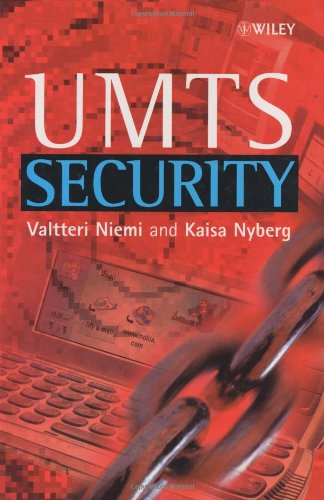Dr Valtteri Niemi, Kaisa Nyberg, Valtteri Niemi, Kaisa Nyberg0470847948, 9780470847947, 9780470091562
Table of contents :
Team kB……Page 1
Contents……Page 8
1.1 Security in Telecommunications……Page 18
1.1.1 General security principles……Page 19
1.1.2 GSM security……Page 22
1.2 The Background to 3G……Page 26
1.3 The 3G Partnership Project (3GPP)……Page 27
1.4 3GPP Network Architecture……Page 29
1.4.1 Elements in the architecture……Page 30
1.4.2 Protocols in the 3GPP system……Page 33
1.5 WCDMA Radio Technology……Page 35
1.5.1 CDMA: an example……Page 37
1.5.2 Basic facts of WCDMA……Page 38
1.5.4 Power control……Page 40
2.1 Access Security to UMTS……Page 44
2.1.1 Mutual authentication……Page 45
2.1.2 Temporary identities……Page 57
2.1.3 UTRAN encryption……Page 59
2.1.4 Integrity protection of RRC signalling……Page 69
2.1.5 Set-up of UTRAN security mechanisms……Page 74
2.2 Interworking with GSM……Page 78
2.2.1 Interworking scenarios……Page 80
2.2.2 Cases with SIM……Page 81
2.2.3 Cases with USIM……Page 82
2.2.4 Handovers from one system to another……Page 83
2.3.2 Identification of the UE……Page 84
2.3.6 Mobile Execution Environment (MExE)……Page 85
2.3.7 Lawful interception……Page 86
3.1 Network Domain Security……Page 88
3.1.1 MAPsec……Page 89
3.1.2 IPsec……Page 96
3.1.3 IPsec- based mechanisms in UMTS……Page 99
3.1.4 Role of firewalls……Page 101
3.2.1 Basics of SIP……Page 102
3.2.2 IMS architecture……Page 105
3.2.3 Architecture for securing access to the IMS……Page 106
3.2.4 Principles for IMS access security……Page 108
3.2.5 Use of HTTP Digest AKA……Page 110
3.2.6 Security mode set-up……Page 115
3.2.7 Integrity protection with ESP……Page 116
3.2.8 Error case handling……Page 119
3.3.1 Higher layer security systems……Page 121
3.3.2 Link layer security systems……Page 123
4.1.1 Cryptographic systems……Page 128
4.1.2 Security and vulnerability……Page 130
4.1.3 Developing cryptology into a publicly available science……Page 131
4.1.4 Public cryptographic development efforts……Page 133
4.2 Requirements and Analysis of Cryptographic Algorithms……Page 134
4.2.1 Block ciphers……Page 135
4.2.2 Stream ciphers……Page 140
4.2.3 Message authentication codes……Page 142
5 3GPP Algorithm Specification Principles……Page 146
6.1.1 Functional requirements……Page 150
6.1.2 Algorithm operation……Page 151
6.1.3 Interfaces to the algorithm……Page 152
6.2.1 Overview……Page 154
6.2.2 Interface……Page 155
6.4 Getting Started……Page 157
6.4.2 Modes around MISTY1……Page 158
6.5 Design Process……Page 159
6.5.2 Design documentation……Page 160
6.5.3 Conclusion of evaluation……Page 163
6.6.2 Description of f8……Page 164
6.6.3 Security……Page 166
6.7.1 Background……Page 167
6.7.2 List of variables……Page 168
6.7.3 Core function KGCORE……Page 169
6.7.4 A5/3 algorithm for GSM encryption……Page 172
6.7.5 A5/3 algorithm for ECSD encryption……Page 173
6.7.6 GEA3 algorithm for GPRS encryption……Page 175
6.7.7 Specification of the 3GPP confidentiality algorithm f8……Page 176
6.7.8 Summary of the confidentiality functions……Page 177
6.8.1 The f9 MAC mode……Page 178
6.8.2 Description……Page 179
6.8.3 Security……Page 180
6.9.1 Length of data……Page 183
6.10.2 Exportability……Page 184
7.1 Introduction……Page 186
7.2.1 Design principles of MISTY1……Page 187
7.2.2 Security of MISTY……Page 191
7.3.1 Changes to the data encryption part……Page 193
7.4.1 General structure……Page 194
7.4.2 KASUMI encryption function……Page 196
7.4.3 Key schedule……Page 202
7.5.1 Properties of components……Page 203
7.5.2 Differential cryptanalysis……Page 207
7.5.3 Truncated differentials……Page 210
7.5.5 Higher order differential attacks……Page 211
7.6 Public Research on KASUMI……Page 212
7.7.1 Parallel operation……Page 213
7.7.2 Implementation attacks……Page 214
8.1 Design Task Force……Page 216
8.2.1 Authentication specification……Page 217
8.2.2 Functional requirements for UMTS authentication……Page 220
8.2.4 Additional requirements from SA3……Page 224
8.3.1 Work plan……Page 225
8.3.2 SAGE’s contribution to the UMTS security architecture……Page 227
8.3.3 Cryptographic requirements……Page 228
8.3.5 Criteria for the cryptographic kernel……Page 229
8.4.2 Notation……Page 231
8.4.3 Specification of the modes……Page 232
8.5 The MILENAGE Architecture……Page 234
8.5.4 The number of kernel operations……Page 235
8.6.1 Block ciphers versus hash functions……Page 236
8.6.2 The kernel of MILENAGE……Page 238
8.7.1 Operator variant parameter……Page 239
8.7.3 Rotation and offset parameters……Page 240
8.8 Conversion to and Compatibility with A3/ A8……Page 241
8.8.1 Conversion rules……Page 242
8.8.2 GSM–MILENAGE……Page 243
8.9.1 Assumptions and security claims……Page 245
8.9.2 Operational context……Page 246
8.9.3 The soundness of the f2–f5* construction……Page 247
8.9.4 Soundness of the f1–f1* construction and its cryptographic separation from the other modes……Page 249
8.9.5 Investigation of forgery or distinguishing attacks with 2^64……Page 251
8.9.6 Conclusions……Page 255
Notation of Parameters, Sets and Functions……Page 258
Abbreviations……Page 264
References……Page 272
Index……Page 282

Reviews
There are no reviews yet.